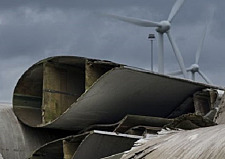Recycling of rotor blades from wind turbines

Thousands of wind turbines will be taken out of commission in the coming years. If no action is taken, the energy transition’s big hope could become a problem. The millions of tonnes of concrete, steel and aluminium can be returned to use via the recycling systems already in place. However, it is more difficult to recycle the rotor blades. There is a lack of transparency about the material flows, and the materials involved – e.g. carbon fibre-reinforced plastics – create difficulties.
How best to recover the valuable raw materials from the rotor blades? This question is being addressed by the RecycleWind Recycling Network – resilient and self-learning research project, which brings together Bremen City University of Applied Sciences, Bremen University and the Bremen-based consultancy brands & values, sustainability consultants.
The first of the approximately 29,000 wind turbines in Germany are now reaching the end of their working lives. The coming years are expected to see a sharp increase in the number of installations being decommissioned. But what happens to the old turbines? If wind energy is to be truly green, the wind sector needs to be able to dismantle them whilst making the most efficient possible use of the materials, and returning the materials to new, high-quality uses in line with the circular economy.
This is not currently happening, and there are at present no signs that the recycling market alone can recover the material resources from the old turbines.
The RecycleWind Recycling Network – resilient and self-learning research project is developing a self-learning recycling network involving the main stakeholders at all stages of the lifetime of wind turbines.
The aim is that the stakeholders (participating companies or government agencies) should jointly stipulate specific but flexible recycling agreements on steering material flows in a way that conserves resources.
RecycleWind is drawing up three methodological elements as preconditions for the agreements:
The agent-based modelling can research scientifically based self-steering methods in the material flow system and simulate the effects of possible actions by the stakeholders.
Since, given a roughly 20-year lifetime for wind turbines, the main parameters will change over time, the recycling network cannot deploy a rigid framework of principles. In contrast to existing steering elements in other sectors with fixed recycling rates, an adaptable self-steering approach is taken.
The concept needs to be able to respond to the changes in the requirements in a robust, adaptable, innovative and improvisation-capable manner, i.e. it needs to be self-learning and resilient. At the same time, the requirements in terms of efficiency parameters (material, energy, climate change mitigation, costs, etc.) need to be met. Depending on the market situation and the stakeholders involved, the recycling strategies and the actual recycling methods will be adapted on an ongoing basis by the stakeholders without missing the stipulated efficiency targets.

This project focus on innovation an is supported by our heroine Felicia